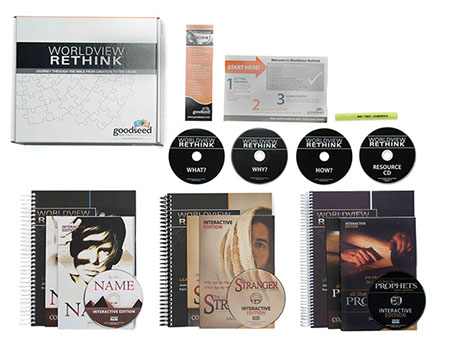HOW GOODSEED TOOLS CAN HELP YOU REACH
INTERNATIONAL STUDENTS
(Reading time: 23 minutes)
The “How to Train” series, describes practical ways in which believers worldwide use our tools to share the message of the gospel.
In this article, we look at how you can use GoodSeed resources to reach into the lives of international students with a clear understanding of the gospel. We have gathered advice and tried-and-tested methods from a spectrum of believers across the world.
These suggestions provide some practical help to better enable you to reach one particular segment that makes up a very large portion of the international community at your doorstep–students who have come to study at a school near you.
We also invite you to share your own experiences with us to benefit others. You can write to us via our contact form.
THE OPPORTUNITY
Brother Andrew, author of the book God's Smuggler, recounted an incident when he sought to remind believers of God's greater plan:
“Ever since Jesus gave the Great Commission, I believe that if we don’t take the gospel to the world, God will bring the world to us. That, I believe, is what we are witnessing here.”
Brother Andrew's observation continues to resonate today. The Great Commission hasn't changed:
Then Jesus came to [the disciples] and said, “All authority in heaven and on earth has been given to me. Therefore go and make disciples of all nations” (Matthew 28:18-19 NIV).
“And you shall be My witnesses… even to the remotest part of the earth” (Acts 1:8 NASB).
We are seeing a massive mixing of cultures and worldviews as people move around the world. The Lord seems to be bringing the world to our doorsteps like never before.
Of the millions who travel to new countries, one particular group emerges, made up of those who are particularly open to reconsidering their worldviews—that is, international students.
Many of these young people come from restricted-access countries. Seeking an experience outside of the familiar, most are curious about the ideas and beliefs of their host country. Beyond the influence of their home country and away from the family and cultural pressures, many are free to explore and learn about “Christianity”—even if they may have some serious misconceptions.
For Ian,* who is involved in student ministries, the openness of international students at his local university has been revealing. He wrote:
“There are a large number of Chinese students who come to Ireland for a year… at our university. Some of them have shown great interest in finding out what the Bible is about. Most had never held a Bible in their hands before! Since October we have been explaining the story of the Bible to about 20 of them through a book called The Stranger on the Road to Emmaus… The novelty of investigating new things in the Irish culture (the Bible being one of them) has worn off and they are now quite serious about coming every week and learning about whether or not God keeps his promise to send the Rescuer.”
Working with international students is a process. It requires commitment to pursue a relationship over a period of time–often several years. This article will walk you through that process, from making preparations, to making contact with international students, to discovering the particular avenue you can take to develop relationships.
We will give suggestions on how you can deepen your friendships and practical steps you can take to clearly explain the gospel in a way that takes into account the challenge of their heart language and whatever worldview barriers that may be present.
A CLEAR VISION
1. Begin with a Clear Vision
Any time we consider outreach into others' lives, our first step must be prayer. Pray for open doors and for hungry, prepared hearts.
At the same time, prepare yourself. Familiarize yourself with tools and resources that clearly explain the Bible’s core message.
GoodSeed has tools specifically designed to explain the central message of the Bible to people from a variety of worldviews. As you become ready, trust God to bring across your path those whom he has prepared.
“Always be prepared to give an answer to everyone who asks you to give the reason for the hope that you have”
(1 Peter 3:15 NIV).
“Be ready whether it is convenient or not”
(2 Timothy 4:2 NET).
As you take the next steps to reach out, remember you must be willing to make this a long-term commitment. The end goal is not evangelism but discipleship; not conversion but genuine friendship.
GET CONNECTED
There may be many foreign students in your community, but how do you make that initial contact? Here are four main ways.
1. Be part of a campus ministry
It’s easy to make the initial connection through an established campus or student ministry that is geared towards supporting international students. You can volunteer your time with one of these groups. Typically these ministries are eager to welcome volunteers to work alongside their staff.
Often, at the beginning of each school year, the orientation week provides an ideal opportunity for international students to connect with services intended to assist them during their stay in their host country. Campus ministries typically set up booths to make contact with these students.
2. International dinners and orientation tours through church outreach
Some churches make an effort to bring international students into their midst by hosting dinners or by providing orientation tours of the town or city. Volunteering in such ministries is a great way to meet international students.
Lien, a young, atheistic Chinese woman, was one such international student who was first introduced to Christianity in this way. Through the relationships she built by attending those dinners, she eventually put her trust in Christ.
3. Participate in programs that seek housing for international students
The Deans are an older couple who, at any one time, may host up to five international students in their home until the students are able to locate more long-term housing. When the students first step off the plane, the Deans are there to greet them and introduce them to their host country. Often, that first contact of welcome and hospitality translates into a long-term friendship, giving the Deans many opportunities to share the gospel.
4. Take personal initiative
If the above ideas are not workable in your situation, then keep a lookout for international students moving into your apartment block, housing estate or neighbourhood. If you work or volunteer at the local library, community centre or with another local community service, there will be natural opportunities to meet them. Opportunities abound; sometimes becoming engaged with the international student community just requires a little creativity.
Jason, desiring to be involved with reaching international students, took a unique approach: he audited a course in order to gain better access to building relationships with students on the nearby university campus.
DEVELOP RELATIONSHIPS
Often, it's not enough to just meet students from out of country. In order for the relationship to develop further, it's helpful to have something you can do that naturally brings you and the students together in order to allow a friendship to develop. Below are just a few ideas that many have found effective:
1. Offer to help familiarize students with their new environment
Kevin and Seana were retired, but chose to get involved in a ministry that helped new international students settle into their city. The couple assisted students in finding accommodation and obtaining furniture. They showed the students around town and even helped them find supermarkets that stocked familiar foods.
Keep in mind that when someone is new to a country, it's the basic needs that are the most pressing. Showing sensitivity to these needs is a great first step in building a relationship. For example, in a cold climate, teaching basic winter survival skills and helping students get suitable warm clothing is very helpful.
2. Assist with transportation and driving lessons
Your system of public transit may differ greatly from what the students are accustomed to in their home country. Introduce them to the best alternatives for travelling around your city. Show them how to purchase a pass or ticket, where to meet their bus and how to read bus or train schedules.
In some situations, the students may wish to purchase a vehicle, so you may find yourself giving driving lessons or car-maintenance tips.
3. Provide English tutoring, mentoring or assistance by proofreading assignments
Veronica, who teaches English to international students, shared with us how she uses English as a tool to build relationships: “If they are new to town, they’re looking for help with their English. I express my willingness to help them learn or sometimes they have heard of me through a friend. So, I start by just teaching English. After a time, there is usually a good opportunity to talk about Easter, Christmas or something having to do with the Bible.”
Offering international students a chance to improve their conversational English or helping them with academic writing may be invaluable for them.
If you have expertise in subjects like mathematics, geography or other specialties, offer your time to help students taking these subjects.
DEEPEN FRIENDSHIPS
As you become better acquainted with the students you spend time with, there will likely come a point where you begin to develop a true friendship, deepening your relationship beyond the practical necessities that initially brought you together. In doing so, it's important to consider the following points:
- As your friendship begins to grow, be patient and don’t force your relationship. Remember that ultimately you are trusting God for greater things.
- Winning a person’s trust is always worth it. Be sincere and honest about your motive in building a relationship. Do so out of a genuine desire of friendship–not because of a short-term interest in winning converts.
- As you begin to reach out, do so with a willingness to take on the role of a learner. Take time to listen to your friends share about how things are done in their countries, about customs or foods they enjoy, and about how holidays and celebrations take place back home.
With the above list in mind, here are some tips for cultivating a strong friendship with the students you meet:
1. Invite them to your home
Receiving hospitality is a big deal for a student away from home! We can communicate a great deal of love and care to a student simply by having them into our homes. Dr. Tom Philips points out how often this important factor is overlooked: “Statistics prove that among international students who study in the U.S., historically 70% have never been to an American home during their stay. More than 85% …have [never had] any meaningful contact with genuine Christians during an average stay of four years.” Needless to say, there is room for improvement. Below are some ways you can show hospitality:
- Who’s not interested in a meal? An informal picnic or BBQ may be a new experience for them. Frequently, they may enjoy the opportunity to cook or bake. (Spontaneous table conversations often provide a natural opportunity to talk about spiritual things.)
- Share family photos.
- Table games may be a welcome diversion from their weekly routine.
- With the approach of exams, some may appreciate having a quiet corner where they can concentrate on their preparations. Open your home to them even when it is not for a social situation involving a lot of interaction.
2. Include them in your celebration of special occasions:
- Holidays, such as Christmas, Easter and Thanksgiving provide a great opportunity to talk about the real meaning of these occasions. Be aware of cultural sensitivities, especially when it comes to food.
When Aaron, a local university student, invited some of his Iranian classmates home for Christmas, special care was taken in the meal preparation so that the dinner would be culturally acceptable.
- An invitation to a birthday or wedding celebration is often eagerly accepted, as it gives the student exposure to your own culture's unique way of celebrating these events. Such outings may naturally reveal to the student aspects of Christian life as well, which may lead to good conversations.
3. Include them in outings, such as:
- Shopping trips
- Sightseeing trips
- Concerts
- Sporting events
- Opportunities to share or learn a hobby or skill, such as photography, tennis, cycling, hiking, skiing, fishing, horseback riding and so forth.
- Retreats and camping experiences
- Something as simple as having a cup of coffee together
4. Allow them to be part of your life
Informal times that aren’t structured or intended to have a specific purpose often allows them to see Christ being lived in and through the experiences of your daily life.
5. Meet their friends and make sure they also feel welcome
6. Attend one of their national cultural events
7. Be sensitive and respectful about the student’s culture
It is always helpful to have a basic understanding of their country of origin. Don’t come across as being ethnocentric—suggesting that your country and your way of doing things is superior.
8. Don’t be put off by preconceived ideas, stereotypes and generalizations
Ask God to help you to see them through his eyes.
9. Don’t assume that male/female interaction and relationships from other cultures are identical to what you are familiar with
What you may consider to be well-intentioned and entirely appropriate may be easily misunderstood.
- Be alert to how those in that culture interact with each other.
- Enjoy group interaction.
- Focus on developing friendships with your own gender.
MOVE TO THE SPIRITUAL
As Christian friends of these students, our ultimate demonstration of friendship is to communicate to them the gospel message. Here are a few points to consider before we look at some specific ways one can clearly communicate the Bible's message.
- Frequently we find that those from other cultures are more open to learning about the Bible and studying its message than those that have grown up in a “Christian” environment. Often they will initiate such a conversation or, at least, indicate that they are willing to learn.
Veronica has certainly found this to be true with the students she has met: “Typically I don’t have to bring up the subject but they will start asking questions after they’re feeling comfortable with me. Either they ask, 'Veronica, would you please teach me the Bible?' or, I might say: 'You know, we’ve been studying English for quite a while and I can tell you’re kind of bored. Let’s have a Bible study. It is really interesting. If you enjoy doing that, we can continue with the Bible or we can stop–it will be up to you.' They always say, 'I didn’t know the Bible was this much fun or was so interesting! Let’s do more!'” Beginning with these sorts of conversations, Veronica has had numerous Bible studies with international students who are eager to learn about the Bible's message.
- Be sensitive as to a student’s learning preference: in a group or alone. Not only will a student feel more comfortable and open in the right learning environment, it will enable you as a teacher to better assess one’s understanding as you progress through the lessons.
Veronica has found that those she meets with are much more open to asking questions if they do so one-on-one or as a husband-and-wife couple. If they’re in a group, they’re very uncomfortable and are concerned about what others are thinking. Often they specifically request to meet one-on-one. In fact, it's not unusual for wives to ask to meet without their husbands present.
- Remember that choosing to trust the Bible's message is often a huge step for those from restricted-access countries. It is not a decision made lightly or without thinking about the reaction of their family and friends when they learn about the students' new beliefs upon return to their home countries.
When Veronica taught the Bible's message to a visiting law professor, he expressed mixed feelings. While he understood and appreciated the Bible's message, he also resisted the message. He told Veronica, “I can’t believe this because if I go back [home], they’ll fire me from my job and put me in prison the rest of my life.” It was no small matter for him to choose Christ. Veronica didn't push the man into making a decision right then. Instead, she continued to pray for him and left the matter with the Lord. A few years later, the professor returned and was quick to contact Veronica again. He indicated that he still felt conflicted. As they met and discussed matters over the next months, Veronica could see a gradual change of mind. Initially, he'd tell her, “I can’t believe it, I can’t believe it… but I just want to learn it.” But later he expressed, “I am beginning to change—I am beginning to believe.” As time went on, he began inviting everyone he met to come to the study. He told Veronica, “Let’s start having dinner parties on the weekends. I’ll invite the people, you be prepared and we’ll ask you questions about the Bible after we eat… because this is really good stuff.”
Explaining a Clear Gospel:
Sharing the gospel despite language, cultural and worldview obstacles
There are four common scenarios you will likely run into as you seek to share the gospel. Taking the time to evaluate each student's situation, as well as your own abilities, will enable you to better address their needs and in the end, have the best chance at explaining the Bible's message in a way that is clear to them.
GoodSeed has developed a number of tools which are ideal for explaining the Bible's message to international students. At the core of our materials is the approach where the abstract is explained using concrete stories. This is vital to overcoming the language and worldview barriers you will likely run into when sharing with a student from a different country.
In addition, GoodSeed has produced books which specifically address three of the most common worldviews.
- By This Name is for those who adopt their own spirituality, making God out to be whatever they want. This is a common mindset in our post-modern, secular world. This book will likely be your most effective tool for outreach with most international students as it also addresses questions arising from polytheism, pantheism, animism, agnosticism and atheism.
- All that the Prophets have Spoken is for those from an Islamic cultural background.
- The Stranger on the Road to Emmaus is for those from a background influenced by Christianity.
There are four options for sharing the gospel with international students using GoodSeed tools. Choose the one that best describes your student:
1. My student is eager to learn the Bible's message and is conversant in English
If this is the case, we recommend obtaining the Worldview Rethink course that is geared towards your student's worldview. Complete with books, workbooks, DVDs and a leader's guide, you will have all the tools you need to guide the student into a correct understanding of the Bible's message. (If you are unable to decide which curriculum to use, default to using By This Name.)

Lien found that it was through By This Name that she was finally able to put all the puzzle pieces of the Bible together: “During that first winter break from college, those involved in the international dinners began a new study of a book called By This Name. This book gave a chronology and summation of the key events of the Bible, as well as an explanation of its message about Jesus Christ and how he came to provide salvation for mankind. That is when I finally connected the dots of those scattered Bible stories I had gathered over the years, resolving much of my confusion.”
Worldview Rethink
 Time Requirement
Time Requirement
You will need approximately 16 hours if you choose the By This Name curriculum (meant for all worldviews) and 12-13 hours if you choose The Stranger (Christianized worldview) or All the Prophets (Islamic worldview) curriculum.
Each worldview is sensitive to the students' questions, providing objective and clear answers that naturally arise from that way of thinking.
Format
The leader will use the leader's guide which contains the full text of the coursebook, plus details on how to teach it, and a section of leader's notes that goes deeper into the content. The leader will simply read the text. The student(s) will follow along in the coursebook and read the Bible verses.
At the appropriate sections, the leader can play the companion DVD for a richer learning experience. Using this format, even a new leader, or one who does not feel particularly gifted at teaching, will be able to guide their student to a clear understanding of the Bible's message.
We often say "If you can read, you can lead." Workbooks complement the teaching. Leaders can check students' understanding using the workbooks which can be done at home or during the sessions.
Learn more about Worldview Rethink
2. My student is open to learning more, but is not willing to commit to an in-depth study OR my student has very limited English language skills
If this is the case, consider reading through one of two small booklets together with the student. This can easily be done in one sitting. Some have found it helpful to use What are Christmas and Easter All About? because those not familiar with these Western holidays are often curious as to their history. Others find the book The Story that Matters more suitable, not feeling tied to giving it away at certain holidays.
The content of both books are the same. The difference is in the style of the art. The Story that Matters has expressive line art that works well across all races and cultures. What are Christmas and Easter All About? has full-colour illustrations.

James and Shelly, who often lead studies with international students, have found these books very useful in reaching those for whom English is a second language. Often after reading through one of these short books, the students' appetite is whetted and they will express interest in learning more. At this point, move to the first option above.
Often, students do with to deepen their Bible knowledge at this point. In this case, proceed to the option 1 using Worldview Rethink.
Time Requirement
Both these booklets are written in easy-to-understand English and can be read aloud in less than an hour.
Read:
Read aloud the gospel story with your students, showing the illustrations as you go along. Pause and ask questions to ensure your listener is following along.
Ask questions:
At the back of the booklets are two sets of questions. The first set checks for understanding while the second set checks to see what your listener believes. Use them where appropriate as you discuss the content with your student(s).
Gift a copy:
Give your students a copy of the book so they can review again for themselves or share it with their friends.
Learn more about What are Christmas and Easter All About?
Learn more about The Story that Matters
3. My student is open to learning more, but I'm not comfortable with teaching or with reading out loud.
If the above options seem intimidating to you, then consider letting a gifted teacher take that burden for you. GoodSeed filmed John Cross as he taught the entirety of The Stranger on the Road to Emmaus, with segments filmed on-location in Israel, Egypt and Jordan. Just pop the DVD in, or view online for free.

Kevin and Seana, who volunteer with an international students' ministry, have found this approach the most suitable for their needs. Kevin admits that he isn’t a great teacher and Seana agrees. Instead, they use The Stranger Videobook and let the DVDs do the teaching. The students then answer the workbook questions together as a form of review.
To help students further, Kevin gives each of them a copy of The Stranger or By This Name in their preferred language (where available) so they can read the message again for themselves. Kevin says that many of the students have understood and put their trust in Jesus.
Time Requirement
This is an 11-hour video series. The six DVDs are divided into a total of 52 sections, ranging between 4 to 27 minutes each. In any given session you can watch as many or as few sections as you like.
Watch:
You can watch the videos together and then discuss what was taught.
Workbook:
Use the accompanying workbook with your student. At the end of each video section, allow your student some time to fill in the workbook. This is a good way to check for their understanding. If they are unclear about a certain question, review the content again.
You may also choose to have your student fill in the workbook at home and the next time you meet, you review it together at the start of the session. Importantly, do not move on ahead until your student is clear on the content.
Learn more about The Stranger Videobook
4. My student could use additional help in understanding the Bible's message due to his or her limited English language abilities.
 Often, along with studying through one of GoodSeed's books in English, teachers find it helpful to give their student a copy of the book in the student's native language. While studying the English version enables you to answer questions and encourages greater participation in the content, nothing quite compares to reading the message in one's heart language.
Often, along with studying through one of GoodSeed's books in English, teachers find it helpful to give their student a copy of the book in the student's native language. While studying the English version enables you to answer questions and encourages greater participation in the content, nothing quite compares to reading the message in one's heart language.
Veronica found it helpful to have both an English and Korean copy of The Stranger as she taught a visiting Korean professor through the Bible's message: “Because his English language skill was weak, having the Korean as well as English edition of the book was advantageous. He would read both before I came. When I arrived, he would already have many parts highlighted along with his questions. We would then talk through his questions about each chapter.”
See if your student's native language is one of the many for which GoodSeed has produced a translation.
Learn more about our translations
What if your student came with a family and young children?
It is not uncommon for mature students to have their families and children in tow when they pursue further education. If you get an invitation to share the message of the Bible with their children or other family members, you might consider using The Lamb.

Time Requirement
It takes two hours on average to read right through the book. Alternatives include reading through it all at once, doing it in two sittings or covering two chapters at a time over five sessions. Take care not to stretch out the time for too long or the story might become disjointed.
Read:
Read the book aloud, showing the full-colour illustrations to help you explain the gospel message.
Ensure Understanding:
Use the questions at the end of each chapter to check for understanding.
Retell:
At the end of the book, allow the child or family member to assist in summarizing the story. You will be able to tell through the summary how much they have understood.
Use the CD:
If appropriate, you can use the CD to reinforce the story. Even when you are not present, they can play it and listen to the story again. This can also assist in learning English.
INTERNATIONAL STUDENT STORIES:
I WANT TO LEARN
ABOUT GOODSEED
The Monthly
GoodSeed eNewsletter
Sign up to receive articles, testimonies, sneak peeks of new resources & upcoming seminars. You'll receive a PDF copy of The Tabernacle: Model of Messiah as a thank you for partnering with us.
© 2023 GoodSeed International. All rights reserved.


